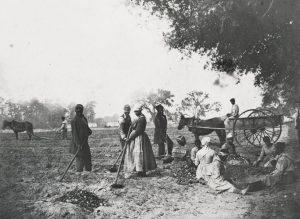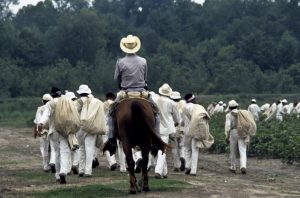
EXPLAINER: Racism built and maintained in America’s food systems
Like healthcare, racial disparities and differences play a part in every organized system across the United States and globally. This includes American food systems from the start of European colonization to present-day inequities.
Slave labor
The first slaves were brought to the U.S. in 1619 for the purpose of completing food and infrastructure labor tasks. Newly arrived Europeans looked to enslave the Indigenous communities, but between deadly diseases and community resistance, colonizers needed another source.
Enslaved people did the work that indentured servants and settlers would not do. It was not financially viable to pay labor to work crops.

Sugar
Of the food crops that grew under the slave labor, sugar has had one of the most significant effects on the world. Dubbed “white gold” the product is one of the most significant foods linking slavery to obesity today.
- By 1850, Louisiana planters made the state the second richest state per capita as it produced 25% of the world’s supply of cane sugar.
- From 1830 to 1850 the enslaved population of the United States rose to 125,000 people (rising 300%.)
- Life expectancy of an enslaved Black person working at a Louisiana sugar parish was 7 years.
- In 1887, 30 sugar workers members of Knights of Labor, a Black union, were killed for threatening to strike. Between lynchings and mass shootings, 60 people died in what would be called the Thibodaux massacre.
- The largest sugar producer in 1942, United States Sugar Corporation in Florida, had such practices that kept workers indebted and killed if trying to escape – were indicted by a federal grand jury for “carrying out a conspiracy to commit slavery.”
All states benefited from enslaved labor
Even as many northern states outlawed slavery, the more industry-based states of the northern U.S. used raw materials stocked through slavery such as indigo, tobacco and cotton to process. For example, textile mills of the northern U.S. required the cotton provided by the south.
The same went for food. From 1839 to 1859, 60% of the nation’s top crop, corn, was provided by the southern states while the northern states had doubled the population. Corn’s status as the top crop was twice as valued as wheat, rye, buckwheat, oats and barley combined. More land was used to cultivate corn and it was seen as more valuable than cotton. Cotton depended on a market, whereas corn, among other foods mostly cultivated by enslaved people, was always deemed valuable because one could eat it.
Accessibility to Healthy Foods
Since enslavement, Black Americans have had limited access to healthy foods. Enslaved Americans were given a carb-heavy diet of foods seen as less nutritious or desirable. From the latter, foods like gumbo, macaroni and cheese, cornbread and chitlins all have become popular staples of “soul food.”
Coined in the rise of 1960s Black pride movements, soul food is defined as foods and techniques associated with African American cuisine. The phrase is considered a celebration of the resourcefulness of enslaved people to make popular dishes despite limited means.
Some of the dishes are staples in “southern food” and can be broken in region specific cuisine like New Orleans’ creole cuisine. Many of the main ingredients are still among the most affordable today like butter, sugar and flour making the diets of Black Americans and economically disadvantaged Americans less nutritious. These same foods are linked to higher blood pressure, hypertension and diabetes for those as young as 12.
Food Stamps
Some economically disadvantaged Americans rely on food stamps to eat. This program is called The Supplemental Nutrition Assistance Program, or for short SNAP.
Pre-COVID-19 2020 SNAP data
- Over 67% of SNAP participants are in families with children.
- Almost 34% are in families that include elders and/or people with disabilities.
- Over 43% are in working families.
The U.S. Department of Agriculture (USDA) found in 2016 those on SNAP spent a smaller percentage of their food budget on fruits and vegetables due to the price. Several programs have tweaked the limitations and budget of a SNAP-like program that allows users to buy more fresh fruits and vegetables with success.
Food deserts
Access to nutrient-rich and high-quality foods is still limited today in the form of food deserts.
Food deserts are low-income areas where access to affordable grocery stores or supermarkets are limited and residents do not have access to transportation. In these areas, residents rely on establishments like convenience stores and fast foods, both of which are less likely to hold fresh produce and fresh vegetables.
Food insecurity and poverty as of 2016
- 13% of all households and 22% of Black American households lived in poverty.
- 18% of children and 33% of Black children lived below the poverty line.
- 10% of those 60+ and 19% of Black Americans 60+ live below the poverty line.
- 12% of all households and 23% of Black American households lacked access to adequate food at some point in 2016.
In 2008, the USDA found 23.5 million people live in food deserts. These were mostly found in areas that are rural, urban and/or made up predominantly of people of color.
Food organizers like Karen Washington have pushed back against the term (food desert) for failing to see the potential and painting a picture of a desolate place. Preferring the phrase “food apartheid,” she told the Guardian it “brings us to the more important question: what are some of the social inequalities that you see, and what are you doing to erase some of the injustices?”
Co-Ops and community gardens
Some communities have addressed this by creating co-ops and community gardens. Co-ops are stores that are owned and run by the community they are in. Like community gardens, co-ops often source the food, vegetables and some of the starches from local sources. Co-ops and community gardens often use labor from the community to sustain themselves. Sometimes this involve tracking hours worked in the field or by stocking or serving as a clerk. Both of these take land, agriculture knowledge and community involvement.
Located in Houston’s historic Third Ward, Project Row Houses supported the incubation in 2014 of the NuWaters Co-op. They use 3 acres of farmland to stock fresh fruits and vegetables in the co-op as well as the coffee beans used in the in-store coffee shop. In addition to this co-op, there are several community gardens hosted by local groups to help bring support to this food desert.
This community, made up of 91% Black and brown residents, have not had a full-service grocery store since the 1990s. In December 2019, after years of advocating, the community of over 15,000 residents got an H-E-B.
COVID-19 has exacerbated issues of food access and food deserts. Budgets are tighter, public transportation is limited, and less nutritious foods last longer in storage so the uptick in food pantry usage nationwide has communities of color and those economically disadvantaged with even more limited options.
Convict leasing and Black farmers
Once slavery ended in the late 1860s, Americans in power used the stipulation at the end of the 13th Amendment of “except as punishment for crime whereof the party shall have been duly convicted” to re-enslave Black Americans. Before the 13th Amendment very few Black Americans were imprisoned because of the effects it would have on the economy. In 1850, the Alabama State Pentiarty had four Black prisoners (all free persons) of the 172 incarcerated people.
Once this slavery became illegal except as punishment for a crime, states heavily enforced Black Codes and other laws to incarcerate newly freed Black citizens. For example, states would enforce vagrancy laws and require newly freed Black men and some poor whites to show written proof of lawful employment.

Once imprisoned, the state would lease out incarcerated people to local farms. There are records of wardens bribing judges for longer sentences and local police to invent crimes. Informal evidence suggested the sheriffs were asked to arrest more people before cotton harvesting season. Prison labor during Reconstruction was 81% cheaper than non-convict labor. This difference affected the price of goods and the local economy. This system helped build up the south’s economy that was devastated by the war.
#StevePrattor the Sheriff of Caddo Parish in Louisiana says keeping some of the “good” prisoners in jail could provide needed labor pic.twitter.com/RqczxnezDW
— Atlanta Black Star (@ATLBlackStar) October 12, 2017
Black Americans make up 12% of the American population,
but 39% of America’s prison population.
Whole Foods came under fire in 2015 for purchasing milk from a private prison. Before vowing to stop, the companies, like others, stated they believed that the income prisoners received (pennies) would help in rehabilitation.As of May 2020, 4,100 corporations profit from America’s prisons and jails, including for food labor needs.
All state prisons ended convict leasing by 1930 while county prisons continue this practice today. From 1970 to 2019 convict leasing has risen alongside the population of incarcerated people.
Black farmers struggle to survive
While some Black families were able to survive displacement and build a legacy on farming, some have found themselves facing systemic racism by the USDA by receiving less money for crop subsidies and disaster aid compared to white farmers.
On a smaller scale, some younger generations of Black farmers are working against these barriers and creating resources for other Black Americans interested in producing crops to do the same.
For more information
Books
- “Unshared Bounty: How Structural Racism Contributes to Creation and Persistence of Food Deserts” by the New York Law School Racial Justice Project and the ACLU
- “Sugar Changed The World: A Story of Magic, Spice, Slavery, Freedom and Science” by Marc Aronson and Marina Budhos
- “Farming While Black: Soul Fire Farm’s Practical Guide to Liberation on the Land” by Leah Penniman
- “Sugar, Slavery, Christianity and the Making of Race” by Mark E. Boren
- “Black Appetite. White Food.: Issues of Race, Voice, and Justice Within and Beyond the Classroom” by Jamila Lyiscott
- “The Color of Food: Stories of Race, Resilience and Farming” by Natasha Bowens
- “An African American and Latinx History of the United States” by Paul Ortiz
- “The Thibodaux Massacre: Racial Violence and the 1887 Sugar Cane Labor Strike” by John DeSantis
- “Blood Sugar: Racial Pharmacology and Food Justice in Black America” by Anthony Ryan Hatch
Documentaries
- “Soul Food Junkies” (2012)
- “Food Deserts: A Film” (2011)
- “Angola For Life” (2015)
- “Rooted” (expected 2021)
- “The 13th“ (2016)
Podcasts
- Episode 2, The Economy That Slavery Built— New York Times 1916 Project Podcast
- “What Are Food Deserts?” — BrainStuff
- Season 3, Episode 1 “Realities of Living in a ‘Food Desert’” — Revfit Radio
- Episode 14, “Traveling to deserts — Food Deserts: You Don’t Have to go Far” — What a Relief! The IRUSA Podcast
- “Soul Food vs. Southern Food: An interview with Food Historian Adrian Miller” — Booking, Culture & Everything In Between
- “This historian wants you to know the real story of southern food” — The Salt (NPR)
